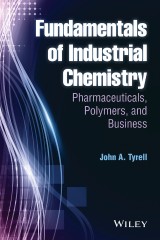Details

Fundamentals of Industrial Chemistry
Pharmaceuticals, Polymers, and Business1. Aufl.
|
72,99 € |
|
| Verlag: | Wiley |
| Format: | EPUB |
| Veröffentl.: | 28.04.2014 |
| ISBN/EAN: | 9781118708668 |
| Sprache: | englisch |
| Anzahl Seiten: | 264 |
DRM-geschütztes eBook, Sie benötigen z.B. Adobe Digital Editions und eine Adobe ID zum Lesen.
Beschreibungen
<p><br /> This book discusses the connectivity between major chemicals, showing how a chemical is made along with why and some of the business considerations. The book helps smooth a student’s transition to industry and assists current professionals who need to understand the larger picture of industrial chemistry principles and practices. The book:<br /> <br /> Addresses a wide scope of content, emphasizing the business and polymer / pharmaceutical / agricultural aspects of industrial chemistry<br /> <br /> Covers patenting, experimental design, and systematic optimization of experiments<br /> <br /> Written by an author with extensive industrial experience but who is now a university professor, making him uniquely positioned to present this material<br /> <br /> Has problems at the end of chapters and a separate solution manual available for adopting professors<br /> <br /> Puts chemical industry topics in context and ties together many of the principles chemistry majors learn across more specific courses</p>
<p><b>1. Introduction 1</b></p> <p>References 3</p> <p><b>2. Inorganic Chemicals 5</b></p> <p>2.1 Sulfuric acid 5</p> <p>2.2 Phosphoric acid 7</p> <p>2.3 Lime 9</p> <p>2.4 Soda Ash 10</p> <p>2.5 Titanium Dioxide 10</p> <p>2.6 Sodium Chloride and Chloralkali 11</p> <p>Questions 14</p> <p>References 15</p> <p><b>3. Gases 17</b></p> <p>3.1 Syn Gas 17</p> <p>3.2 Nitrogen and Oxygen 24</p> <p>3.3 Ammonia 26</p> <p>Questions 31</p> <p>References 32</p> <p><b>4. Patents 35</b></p> <p>Questions 43</p> <p>References 46</p> <p><b>5. Petrochemicals 47</b></p> <p>5.1 Crude Oil 47</p> <p>5.2 Coal, Natural Gas and Shale Oil 52</p> <p>5.3 Ethylene 53</p> <p>5.4 Propylene 57</p> <p>5.5 BTX 59<br /> <br /> Questions 60</p> <p>References 61</p> <p><b>6. Business Considerations 63</b></p> <p>6.1 Introduction 63</p> <p>6.2 Six Sigma 64</p> <p>6.3 Stage-Gate™ 66</p> <p>6.4 Organization 68</p> <p>6.5 Gantt Charts 70</p> <p>6.6 Cost Estimates 71</p> <p>6.7 Scale-up Considerations 75</p> <p>Questions 82</p> <p>References 83</p> <p><b>7. Polymer Basics 85</b></p> <p>Questions 104</p> <p>References 106</p> <p><b>8. Some Industrially Important Polymers 109</b></p> <p>8.1 Polyethylene 109</p> <p>8.2 Polypropylene 112</p> <p>8.3 Polyvinyl Chloride 113</p> <p>8.4 Other Olefin Polymers 116</p> <p>8.5 Polyester 117</p> <p>8.6 Polycarbonate 121</p> <p>8.7 Nylon 122</p> <p>8.8 Polyimide 125</p> <p>8.9 Fluoropolymers 126</p> <p>8.10 Polyphenylene Sulfide 128</p> <p>8.11 Acetal Resin 129</p> <p>8.12 Thermosets 130</p> <p>Questions 136</p> <p>References 139</p> <p><b>9. Blends and Additives 141</b></p> <p>9.1 Blends 141</p> <p>9.2 Antioxidants 143</p> <p>9.3 UV Stabilizers 147</p> <p>9.4 Antistatic Agents 148</p> <p>9.5 Peroxides 149</p> <p>9.6 Lubricants 151</p> <p>9.7 Flame Retardants 151</p> <p>9.8 Heat Stabilizers 155</p> <p>9.9 Plasticizers 156</p> <p>9.10 Others 157</p> <p>Questions 159</p> <p>References 161</p> <p><b>10. Pharmaceuticals 163</b></p> <p>10.1 The Drug Development Process 163</p> <p>10.2 Regulation 165</p> <p>10.3 Synthetic Considerations 169</p> <p>10.4 Chirality 172</p> <p>Questions 179</p> <p>References 181</p> <p><b>11. Pharmaceuticals–Some Important Drugs 183</b></p> <p>11.1 Introduction 183</p> <p>11.2 Cholesterol Drugs 184</p> <p>11.3 Hypertension 187</p> <p>11.4 Proton Pump Inhibitors 193</p> <p>11.5 Diabetes 195</p> <p>11.6 Antidepressants 198</p> <p>References 201</p> <p><b>12. Agricultural Chemicals 203</b></p> <p>12.1 Overview 203</p> <p>12.2 Fertilizer 204</p> <p>12.3 Insecticides 205</p> <p>12.4 Herbicides 211</p> <p>12.5 Fungicides 217</p> <p>References 219</p> <p><b>13. Design of Experiments and Statistical Process Control 223</b></p> <p>13.1 Introduction 223</p> <p>13.2 Design of Experiments 229</p> <p>13.3 Statistical Process Control 232</p> <p>Questions 237</p> <p>Reference 237</p> <p><b>14. Safety and Environmental Considerations 239</b></p> <p>14.1 Safety and Responsible Care 239</p> <p>14.2 Environmental Compliance 243</p> <p>14.3 Green Chemistry 245</p> <p>Questions 249</p> <p>References 250</p> <p><i>Index 251</i></p>
<p>“Useful for students in chemistry or chemical engineering as well as entry-level industrial employees.” (<i>Choice</i>, 1 February 2015)</p> <p> </p>
<p><b>John Tyrell </b>teaches a number of chemistry courses that include Industrial and Polymer Chemistry in the Department of Chemistry and Biochemistry at the University of North Carolina Wilmington. Dr. Tyrell holds sixty-eight patents and has more than twenty years of industrial research experience, at Lederle Laboratories, General Electric Plastics, and OxyChem. He co-authored the book <i>Fundamentals of Heterocyclic Chemistry: Importance in Nature and in the Synthesis of Pharmaceuticals</i> which was published by Wiley.</p>
<p>This book offers a broad understanding of several different topics important to industrial chemistry. It discusses the connectivity between major chemicals, showing how a chemical is made along with why and some of the business considerations. (For example, the synthesis of chlorine is used to illustrate the concept of coproduction, captive use, and demand; the major outlet for chlorine is to make PVC which is tied to the housing market; the raw material cost of PVC is less dependent upon petroleum pricing than the other major polymers.) Not intended to give expert detail on all areas, the textbook gives an overview background putting chemical industry topics in context and tying together many of the principles chemistry majors learn across more specific courses. By exposing readers to these important industry topics, the book helps smooth transition from a student to an industrial professional and also assists those already in industry who may be missing a larger picture through narrow focus on a particular chemical area only.</p>


















